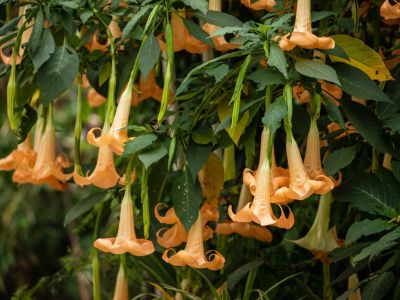Brugmansia Cold Tolerance
One of the most dramatic plants is Brugmansia. Also known as Angel Trumpets, Brugmansia is a shrub-like tropical perennial in warm zones but is grown as an annual in cold climates. This is because there are not hardy, and the plants cannot withstand cold temperatures. The plants can be overwintered indoors with reasonable success, so you can save them and have another chance at viewing the tremendously large hanging blooms in your landscape. This plant is not considered a hardy plant, which means it cannot withstand freezing temperatures. While the zones the plant can live in are 8 to 11, Brugmansia cold tolerance in zone 8 is marginal with some shelter and deep mulching, as temperatures may get down to 10 or 15 degrees Fahrenheit (-12 to -9 C.). Zones 9 to 11 stay between 25 and 40 degrees Fahrenheit (-3 to 4 C.). If any freezing occurs in these zones, it is very brief and doesn’t usually kill the roots of the plants, so Brugmansia can be left outdoors in winter. Overwintering Brugmansia indoors in any of the lower zones is recommended or the plants will die.
Overwintering Brugmansia
Since there are no truly hardy Angel Trumpets, it is useful to know your zone and take appropriate action in cool regions to save the plant. If you are in an area where temperatures regularly freeze in winter, you need to start tricking the plant into dormancy in late summer to early fall. Stop fertilizing Brugmansia by July and reduce watering in September. Gradually, this will push the plant into a dormant state as temperatures get cooler. Remove 1/3 of the plant material to reduce the possibility of damage during moving and prevent excess moisture loss from transpiration. Before any freezing temperatures are expected, move the plant to a cool, frost free area such as the basement or possibly an insulated garage. Just make sure the area doesn’t freeze and temperatures are between 35 and 50 degrees Fahrenheit (1 to 10 C.). During winter storage, water infrequently but keep the soil lightly moist. Once temperatures begin to warm up, bring the plant out of the area in which it has been hiding and gradually introduce it to brighter and brighter light. Container plants will benefit from repotting and new soil. Harden off the plants before putting them outside. Over the period of several days reintroduce the plants to outdoor conditions, such as wind, sun, and ambient temperatures, then plant them in the ground or leave the containers outside when nighttime temperatures do not fall below 35 degrees Fahrenheit (1 C.). Once you see new growth, begin fertilizing monthly with liquid fertilizer to boost green growth and help form the 6-inch (15 cm.) flowers. Taking a little care to remember Brugmansia cold hardiness zones and get these plants indoors in time before any frosts can ensure that you enjoy them for years and years.
